| Prep Time | Cook Time | Servings | Cuisine | Difficulty |
|---|---|---|---|---|
| 15 minutes | 1 hour 30 minutes | 4 servings | American | Intermediate |
Table of Contents
Welcome to the ultimate guide on crafting the perfect Smoked Ribeye Steak! Whether you are a seasoned pitmaster or a home grilling enthusiast, this guide will take you through every step of creating a flavorful, juicy ribeye that rivals the best gourmet steak dishes you’ve ever tasted. From selecting the right cut to mastering the smoking technique, we’ll explore how to elevate a simple ribeye into a show-stopping meal that leaves your family and guests asking for more.
This recipe emphasizes smoky, rich flavors while keeping the meat tender and juicy. Smoked ribeye steak is a beloved classic in American cuisine, often celebrated in backyard barbecues, tailgate parties, and fine-dining-inspired home meals. By following this guide, you’ll learn not only how to smoke ribeye steak properly but also the tricks that make it unforgettable.
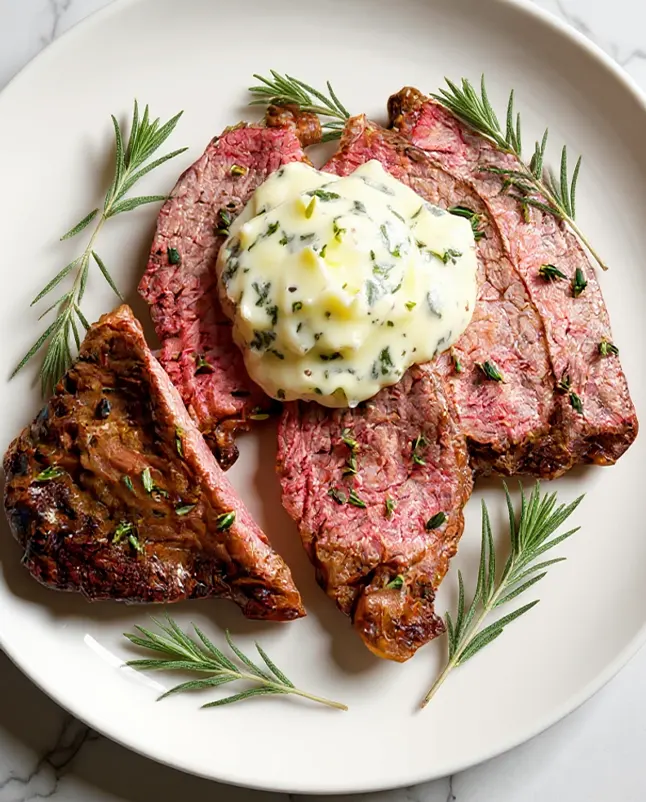
Why make Smoked Ribeye Steak?
Choosing to smoke a ribeye steak instead of pan-searing or grilling provides several advantages. First, smoking imparts a deep, smoky flavor that simply cannot be replicated with other cooking methods. The low-and-slow process allows the meat to cook evenly while preserving its natural juices, resulting in a tender, melt-in-your-mouth experience.
Additionally, smoked ribeye steaks stand out in terms of presentation and taste. They develop a beautiful, rich crust on the outside while maintaining a juicy, flavorful interior. For those aiming to impress at gatherings or to enjoy a premium meal at home, smoking your ribeye steak is a clear winner. This method pairs wonderfully with robust side dishes, making your dinner truly memorable.
Lastly, mastering smoked ribeye steak opens doors to exploring a variety of smoked meat recipes and other gourmet steak dishes. Once you understand the fundamentals, experimenting with different rubs, wood chips, and flavor profiles becomes both fun and rewarding.
History and Origin
The ribeye steak has roots in the American barbecue tradition, where smoking meats became an art form over centuries. Originating from well-marbled cuts of beef, the ribeye is prized for its tenderness and rich flavor. Early American pitmasters discovered that slow-smoking these cuts over hardwood, such as oak or hickory, transformed a simple steak into a culinary masterpiece.
Over time, the practice of smoking ribeye steaks evolved, incorporating diverse rubs, marinades, and smoking techniques. Today, it represents both a classic and a contemporary approach to steak preparation. From backyard grills to upscale steak houses, the smoked ribeye has become a symbol of American culinary ingenuity, celebrated for its depth of flavor and impressive presentation.
Ingredients for Smoked Ribeye Steak
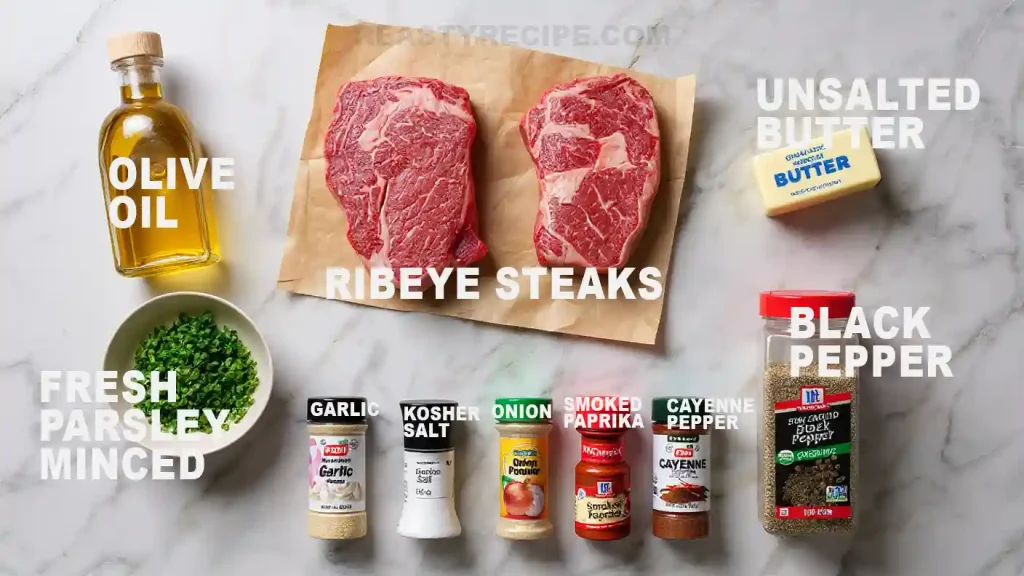
- 2 bone-in ribeye steaks, 1.5 to 2 inches thick
- 2 tablespoons olive oil
- 2 tablespoons kosher salt
- 1 tablespoon freshly ground black pepper
- 1 tablespoon garlic powder
- 1 tablespoon smoked paprika
- 1 teaspoon onion powder
- 1 teaspoon dried thyme
- 1 teaspoon cayenne pepper (optional for heat)
- Wood chips (hickory or oak recommended) for smoking
- Optional finishing butter: 2 tablespoons unsalted butter, 1 teaspoon fresh parsley, minced
Instructions
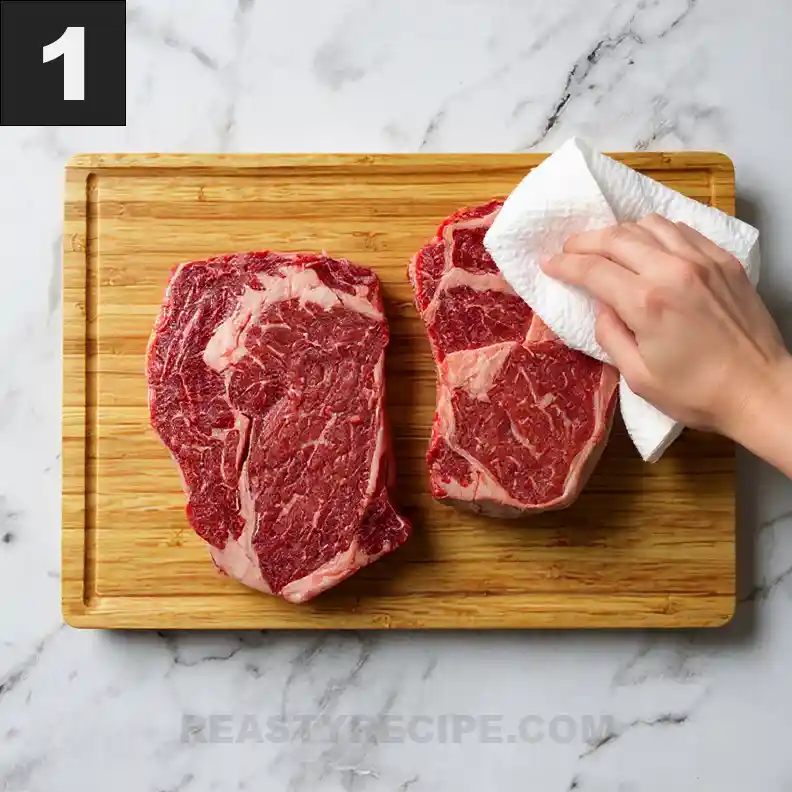
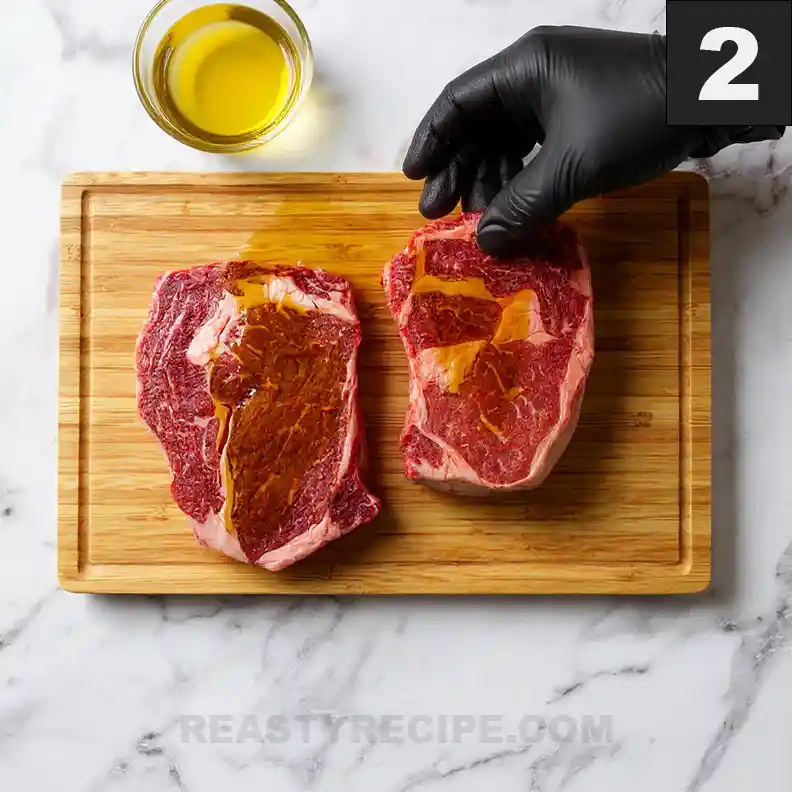
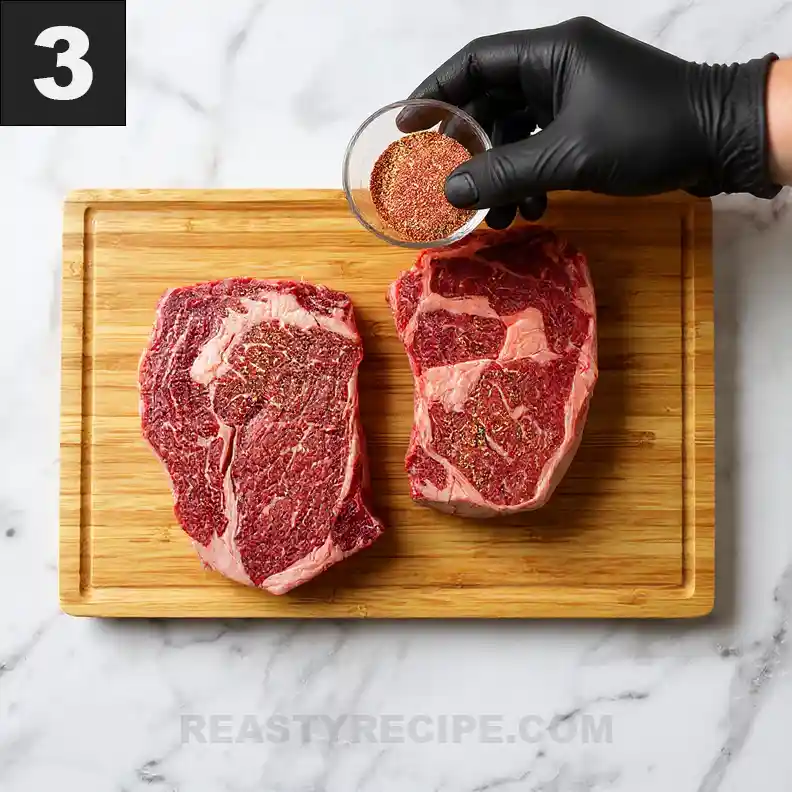
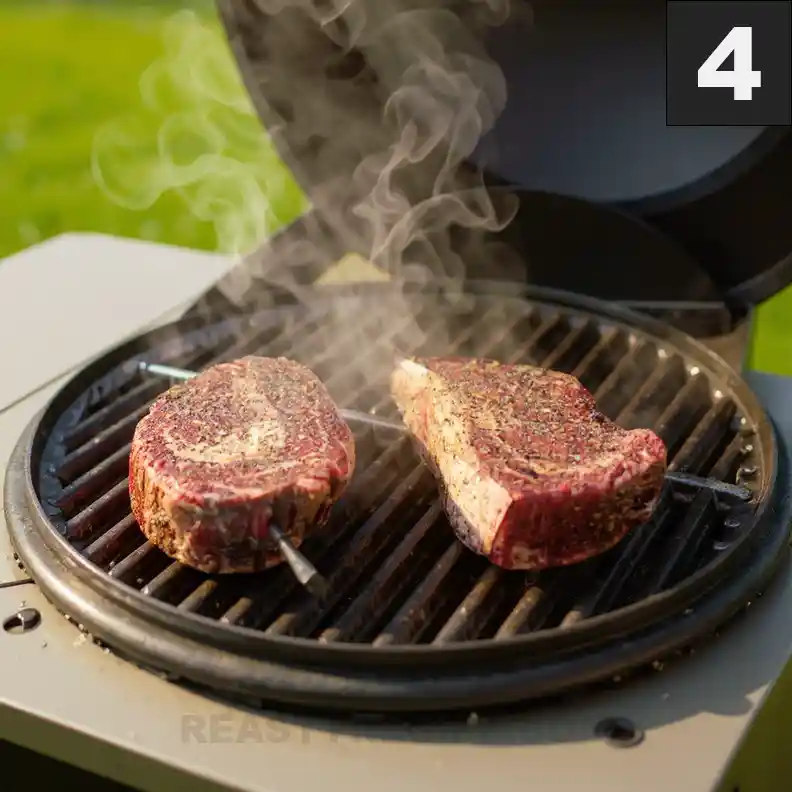
- Begin by preparing your ribeye steaks. Pat them dry with paper towels to remove excess moisture. This helps achieve a better crust when smoking.
- Rub each steak evenly with olive oil. In a small bowl, combine salt, pepper, garlic powder, smoked paprika, onion powder, thyme, and cayenne pepper. Massage the seasoning into each side of the steak, ensuring full coverage.
- Preheat your smoker to 225°F. Add your preferred wood chips, hickory or oak provide the most traditional flavor.
- Place the steaks directly on the smoker rack, ensuring they are not touching to allow for even smoke circulation.
- Smoke the ribeye steaks for approximately 1 hour to 1 hour 15 minutes, or until the internal temperature reaches 125°F for medium-rare or 135°F for medium. Use a meat thermometer for accuracy.
- Remove the steaks from the smoker and let them rest for 10 minutes. Resting allows the juices to redistribute throughout the meat.
- Optional: Melt butter with minced parsley and brush over the steaks for added richness and flavor.
- Slice against the grain and serve hot alongside your favorite sides.
Common mistakes to avoid
- Over-seasoning or under-seasoning – balance is key for the perfect smoked ribeye steak.
- Skipping the resting period – cutting too soon can cause juices to spill out, leaving the steak dry.
- Using wet wood chips – wet chips may produce too much smoke and create a bitter flavor.
- Cooking at too high a temperature – smoking requires low, steady heat to achieve tenderness.
- Ignoring the meat thermometer – guessing the internal temperature can lead to overcooked or undercooked steak.
Chef Steve Tips
- For an extra layer of flavor, try a light marinade of olive oil, garlic, and fresh herbs before seasoning with dry rubs.
- Experiment with different wood chips like cherry or pecan to create unique flavor profiles.
- If you prefer a slightly charred crust, finish the steak on a hot grill or cast-iron skillet for 1–2 minutes per side after smoking.
- Rest the steaks under a loose foil tent to keep them warm while preserving juiciness.
- Always slice against the grain to maximize tenderness and create a more enjoyable eating experience.
Sauces and Serving Ideas
While smoked ribeye steak is delicious on its own, pairing it with complementary sauces can elevate the dish. Here are some options:
- Garlic Herb Butter: Adds richness and aromatic flavor.
- Smoky Pepper Sauce: Enhances the natural smokiness.
- Chimichurri: A fresh, zesty sauce that brightens the deep flavor of the meat.
Serve your smoked ribeye steak with classic sides such as roasted vegetables, mashed potatoes, or a crisp garden salad. For a more indulgent experience, pair with baked mac and cheese or creamy corn pudding. The beauty of this steak is its versatility, perfect for casual dinners or special occasions.
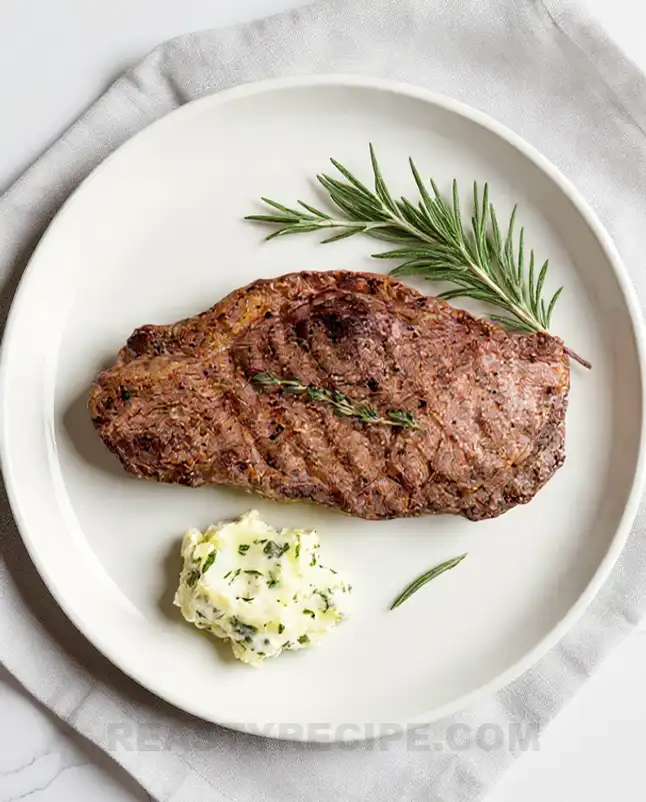
Nutrition
A typical smoked ribeye steak (8 ounces) contains approximately:
| Calories: | 600–650 kcal |
| Protein: | 55g |
| Fat: | 45g |
| Carbohydrates: | 0g |
| Fiber: | 0g |
| Sodium: | 850mg (depending on seasoning) |
While rich and indulgent, smoked ribeye steak offers high-quality protein and essential nutrients such as iron and vitamin B12. To balance the meal, serve alongside nutrient-dense vegetables and whole grains.
Final Thoughts from Chef Steve
Smoking a ribeye steak is both an art and a science, combining patience, skill, and attention to detail. The process transforms a simple cut of beef into a gourmet masterpiece that is flavorful, tender, and deeply satisfying. By following these steps, avoiding common mistakes, and embracing the tips shared, anyone can create a top-rated smoked ribeye steak in their own kitchen or backyard.
Remember, the key to success lies in the balance of heat, smoke, and seasoning. With a little practice and a lot of enthusiasm, you’ll master the techniques and enjoy the rewards: juicy ribeye steaks bursting with flavor, perfect for family dinners, special celebrations, or impressive gatherings.
So fire up the smoker, get your wood chips ready, and prepare to experience the ultimate smoked ribeye steak. Your taste buds will thank you!
FAQs
1- What is the best wood for smoking ribeye steak?
Hickory and oak are classic choices, offering a rich, smoky flavor. Cherry or pecan can add a sweeter profile.
2- How long should I smoke a ribeye steak?
Approximately 1 to 1.5 hours at 225°F for a medium-rare to medium steak. Use a thermometer for precision.
3- Can I smoke ribeye without a smoker?
Yes, you can use a charcoal or gas grill with a smoker box or foil pouch filled with wood chips to achieve a similar flavor.
4- Should I salt my steak before smoking?
Absolutely. Salting at least 30 minutes before smoking enhances flavor and improves crust formation.
5- How do I keep my smoked ribeye steak juicy?
Low and slow smoking, resting the steak after cooking, and slicing against the grain help retain juices and tenderness.

You May Also Like
Grilled Beef Tenderloin
Grill Flank Steak with Overnight Marinade
Tender Chuck Roast on a Pellet Grill
Greek Lamb Meatballs